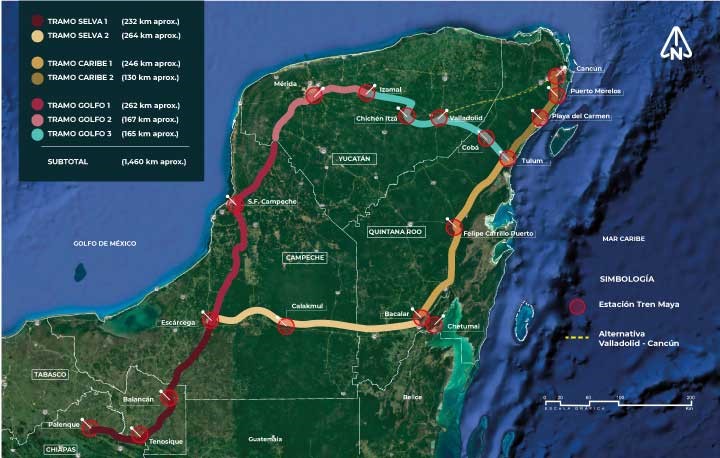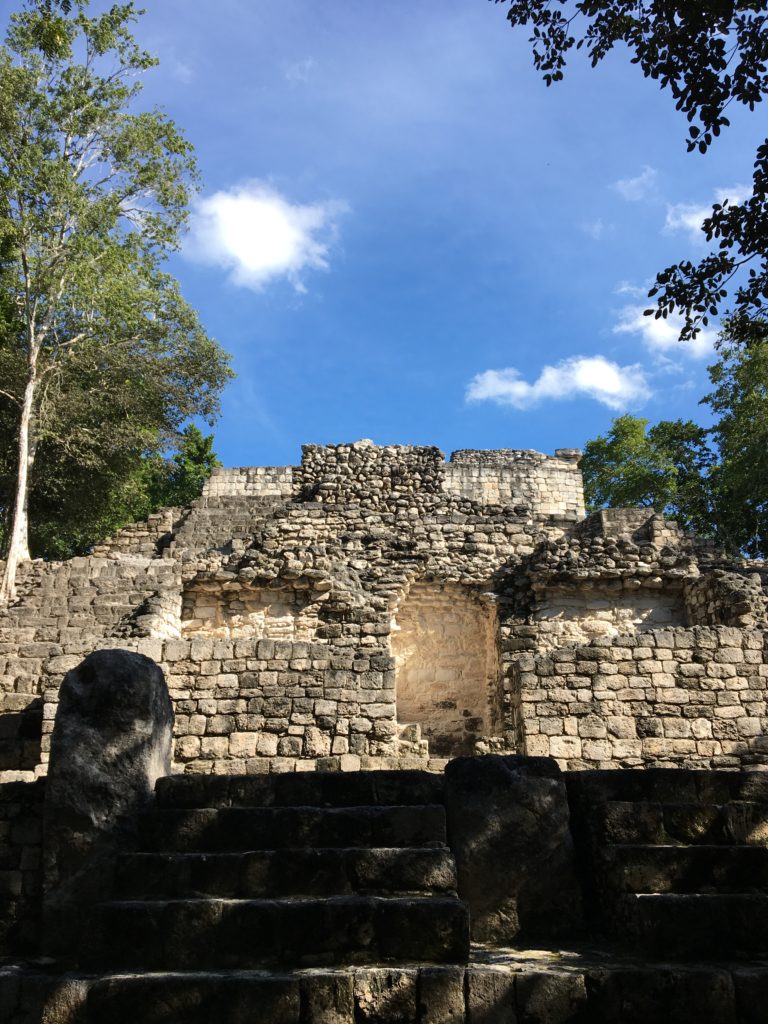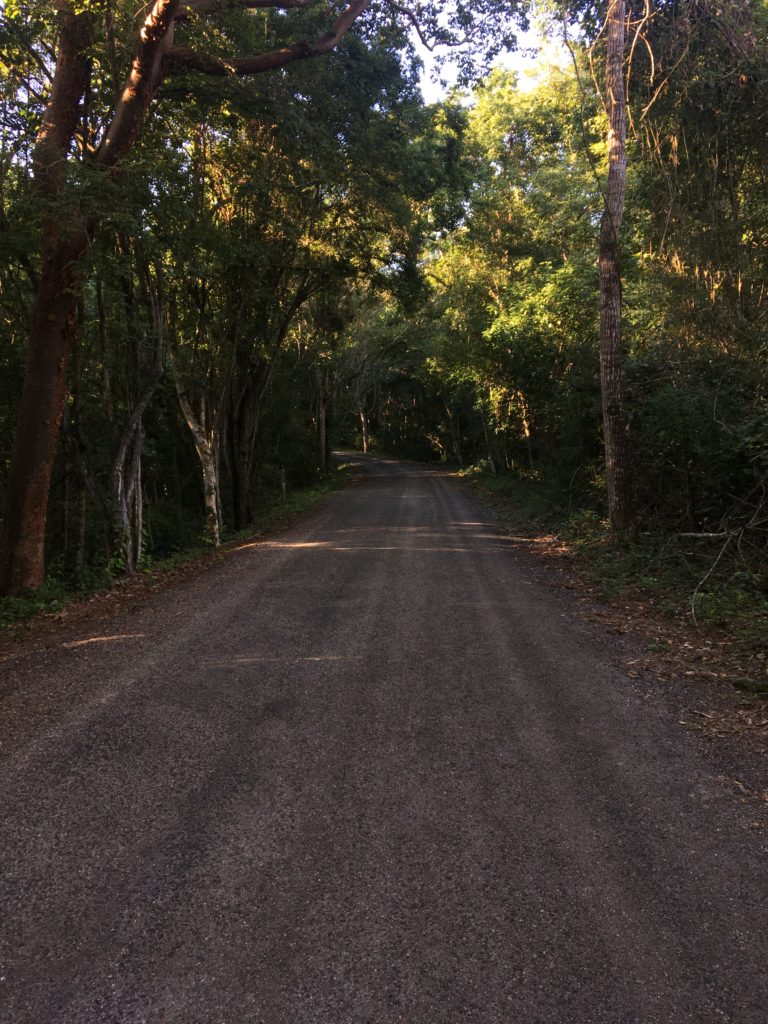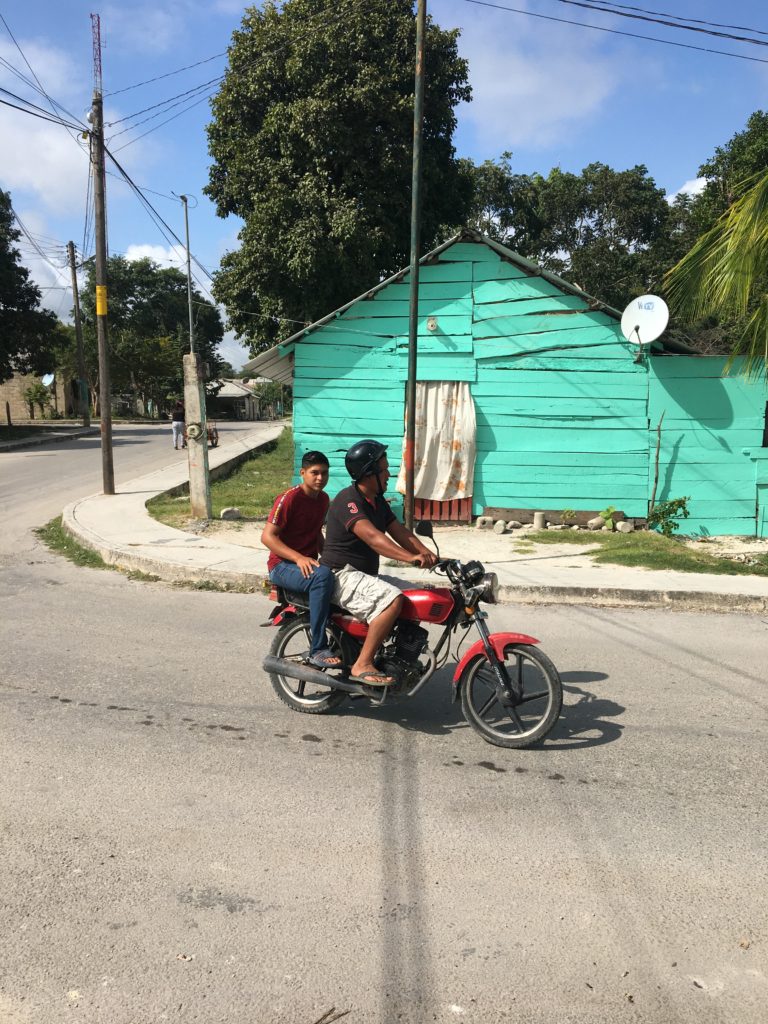Cameras rolled as dozens of members of Mexico’s National Guard formed a tight line, and, holding up shields and batons, pushed forward into a group of Central American migrants. They sprayed tear gas, forcing people to disperse towards the border with Guatemala. Images of families running in panic and fear flooded social networks. Parents were separated from their children. During the first month of 2020, at least 2,000 people were deported from Mexico and many hundreds detained.
The deployment of the National Guard –a military force of soldiers, Federal Police, marines and new recruits– is but the most visceral element of President Andrés Manuel López Obrador’s plan to control migration in Mexico’s south. Another is the Tren Maya, a train across the Yucatán peninsula, which is the largest infrastructure project proposed by Mexico’s new president.
The National Development Plan (PND), the guiding policy document of López Obrador’s presidency, states that the peninsular train will serve to contain northward migration by “generating employment and conditions of dignified life to attract and anchor those who are fleeing poverty.” But critics liken the train to a border wall without bricks, and say the project has more to do with displacement than it does with transportation.

“As we’ve been saying since the outset, the main problem isn’t the train itself, rather, it’s what comes with the train,” said Pedro Uc, a Mayan activist and writer from the town of Buctzotz, Yucatán. “We think they could connect the Trans-Isthmus corridor to this project and that it will become… A wall without bricks, which will be used to contain the people coming up from Central America,” said Uc. He predicted that new cities could swell as service industry jobs connected to mass tourism are created along the train’s route. “That will obviously have repercussions in the lives of people and communities.”
The Trans-Isthmus corridor that Uc mentions is an existing freight path of rail lines and highways connecting the Pacific and Atlantic. The isthmus is the narrowest part of the map of Mexico, and the corridor across it is another in the series of infrastructure project proposed by the current government.
The Yucatan Peninsula, which is made up of the states of Campeche, Yucatan and Quintana Roo, juts northeast from the isthmus into the Caribbean. Like the peninsular train, the idea of a Trans-Isthmus corridor has been floated before, but this time, the government seems set on making the controversial proposals reality.
Indeed, the peninsular train is best understood as part of a series of strategic infrastructure and social programs promoted by President López Obrador, who is known in Mexico as AMLO. Others include the Trans-Isthmus corridor, a free trade zone along the Mexico-US border, and a program called Sembrando Vida, in which small farmers plant fruit trees in return for monthly payments.
“This combination of mega-projects and infrastructure, when we lay them out on a map… are de facto elements of a ‘migrant barrier’ which respond to the geopolitical interests of the United States,” according to Dr. Sergio Prieto, a professor at Ecosur in Campeche, in southern Mexico. According to the peninsular train’s official website, it “is a comprehensive project of territorial organization, infrastructure, economic growth and sustainable tourism.” It is the promise of “territorial organization” that most worries local activists.
“Many ecologists and environmentalists have been focusing on where the tracks will be laid, how many trees will be cut, and the animals,” said Abraham Villaseñor, an urbanist and resident of Calakmul, a town slated to host a station along the train’s southern route. “We think that’s too simplistic, and that those who are promoting the project are pushing the discussion into that terrain,” he said during an interview on the front porch of his home. It is easier for the government to talk about reforestation, after all, than it is to talk about the impacts of building new cities and promoting mass tourism in peasant and Indigenous communities.
The Tren Maya and the model of Cancun
Calakmul is a rural municipality located deep in the biosphere reserve of the same name. Calakmul is also the name of an impressive archeological area that was pillaged and looted for nearly a century before it was officially recognized by the Mexican government in 1994. Although still relatively difficult to access, the 300-foot-tall pyramids at Calakmul are held up as a key draw for the thousands of tourists who would arrive, theoretically, to the area every day once the southern line of the peninsular train is up and running.

When the peninsular train was first announced, there was talk of building Comprehensive Planned Centers (CIP) along the route. “We said, ‘Hey, what you’re planning is, in this day and age, a new Cancun in an area like Calakmul, where the fragility of the ecosystem has already shown its limits,’” said Villaseñor as he sat back to pet his cat. “Why would they want to repeat the mistakes of Cancun?”
For tourists, Cancun elicits elysian afternoons, white sand beaches, all-inclusive hotels and partying on the strip. But for many who live in smaller towns and communities near Cancun, the word is synonymous with inequality, exploitation, environmental collapse and, more recently, state and paramilitary violence connected to the militarization of the drug trade. Last year, Cancun averaged one murder a day. In the first month of 2020, there were over 50 killings in the city.
Cancun’s transformation from sparsely populated natural area to tourist behemoth began in the early 1970s when it became the first CIP built by the Mexican government. Today, the city has a population of over 600,000 and offers up more than 100,000 hotel rooms. In 2019, Cancun received over 13 million passengers by air, and another seven million visitors by cruise ship.
The Riviera Maya, which includes Cancun, Playa del Carmen and Tulum, is a major moneymaker for private hotel companies and for the Mexican government, which is determined to spread the tourist dollars around the peninsula. The idea is that some of the tourists streaming into Cancun would ride the peninsular train to visit colonial cities, archeological sites, and natural areas. In addition to passengers, the train is also slated to carry cargo, including hydrocarbons.
Hard facts about the peninsular train are sparse and the details ever-changing.
Here’s what we know so far. The train itself would run along approximately 930 miles of track. Cancun would connect with stations at tourist destinations large and small, all the way south to Chetumal. From Tulum, a train line would run west, with stops at Valladolid, Mérida and Campeche. A southern line would turn west across the peninsula at the fragile turquoise lakes of Bacalar. The southern and northern lines would meet in the town of Escárcega, where a single track would bring passengers to the terminus station in Palenque, Chiapas.
The train is to have 30 stops, 19 of which would host train stations. It would pass through 112 municipalities. Work for the northern route has started along existing tracks, and new tracks along the southern route are set to be laid this year. Carlos Slim, the country’s richest man, supports the project and successfully pushed for a new route so the train won’t compete with a toll highway he controls. To this day, the exact location of the tracks and stations has not been made public, though official documents note that most of the route will run parallel to existing federal infrastructure such as power lines and highways.
There is little official information about the new urban areas the federal government is proposing to build at the 19 train stations, which have also been called CIPs, “development poles,” or “new urban nuclei.” These areas are expected to involve housing, hotels, and shopping malls, representing a strong break with rural life and holding the potential to displace communal landowners.

One report stated the new city in Calakmul could become home to 50,000 people and receive three million tourists a year. To put that into context, the 2015 population of the more than 80 ejidos (agrarian communities) that make up Calakmul was 28,000; the largest of these, Xpujil, has a population of about 4,000.
To date, there is no detailed information on water supply, sewage, or garbage disposal for the proposed cities. These are not minor issues since people across the peninsula rely on septic tanks, there is no water treatment, and garbage is often burned.
Train tracks, train cars and train maintenance is estimated to cost between six and eight billion dollars. But that estimate doesn’t include the stations. The still-vague proposals for financing the project hint at the lack of basic information. Initially, the Mexican government said it would pay 10 percent of the cost of the train, with the rest coming from private investment. In October, the National Fund for Tourism Development (FONATUR) upped the estimate of the government’s share to 30 percent. Then, in December, AMLO said the entirety of the project would be financed by the Mexican government. FONATUR maintains they are still expecting significant private investment.
Further complicating the proposal to build new cities is the fact that much of the land in the Yucatán peninsula is held collectively through ejidos, collective rural landholding associations which were still being created well into the 1960s as the Mexican government promoted new settlement in the region.
The government has proposed the creation of the Infrastructure and Real Estate Trust, called FIBRA for short, which would rent land from collective landowners to build train stations and urban centers. “It’s not about selling, it’s about organizing and then receiving long-term rental payments so that [collective landholders] are not displaced,” said Rogelio Jimenez Pons, head of FONATUR, in an interview with El Financiero. “If an important investor arrives and wants to invest in a mall or a hotel, it isn’t sold, it’s rented, and the vehicle for doing so is a trust.”
But according to Dr. Violeta Núñez Rodríguez, who researches mega-projects at the Autonomous University of Mexico in Xochimilco, the involvement of communal landowners in the project is much more complicated than it appears. In order to legally lease to FIBRA, she said, these landholders, known as ejidatarios, would have to become private landholders. This is a lengthy and complicated process that is often met with community resistance.
In addition, the land trust as proposed would be listed on the Mexican Stock Exchange, subjecting rural landowners to the whims of the market. “There is a large element of risk. Part of that risk is what we call variable rent, which is not guaranteed and which, depending on the stock exchange, could impact the investments made,” said Núñez Rodríguez. In addition, because the FIBRA would list shares on the stock exchange, decision-making power would lay with majority shareholders, not with the landowners.
Activists dispute the idea that long-term leases (50-80 year contracts) or the use of a land trust would prevent the displacement of farming communities from their lands. “It’s displacement, even though they don’t want to say it,” said Villaseñor. “It’s displacement.”
Sham Consultations
The planned completion date for the project is ambitious: the train is to be up and running by 2024, in time for AMLO to inaugurate the project before he leaves office at the end of his six-year term. The politically influenced timeline means plans for the peninsular train have barrelled ahead.
On November 15, FONATUR announced it would carry out information sessions at the end of the month, and on December 15th, it organized a vote for or against the project in 15 Indigenous communities in the peninsula. This vote took place before communities had access to basic information about the plan, such as the train’s route, the location of stations, and other development associated with the project.
“It all happened so fast. It overwhelmed us,” said Sara López, who is part of the Regional Indigenous and Popular Council of Xpujil (CRIPX), which is part of Mexico’s National Indigenous Congress. “It wasn’t prior consultation, nor was it free, nor was it in good faith. It wasn’t adequate. The people were not properly informed,” she said during an interview outside a small hotel in the town of Xpujil, which is the municipal center of Calakmul.
Few places could feel farther from Cancun than Xpujil: the dry, dark nights are incredibly quiet, and lodging is extremely modest (I stayed in a wooden bungalow with a fan and a mosquito net for $10 a night). There’s no five star hotels with swimming pools in Xpujil for a number of reasons: to date, tourism has been led by adventurous travelers seeking to reach the out-of-the-way archeological site, but also, and much more importantly, there’s no water.
One resident of Xpujil told me water had only flowed from the municipal water system through the pipes in his home three times over the past five months. For the most part, water is delivered by truck.

In small clearings in the woods all around Calakmul, peasant and Mayan communities practice small-scale agriculture and beekeeping, but there is no irrigation. Crops depend entirely on rainfall, which has been less frequent in past years, leading to crop failure and causing some families to go hungry. It is in this context that the Tren Maya has been presented to communities as a panacea, a solution for all the problems they’re facing.
On November 30, ejido leaders were brought from throughout Calakmul to the information session in Xpujil. Numerous sources confirmed that a government flyer being read aloud in Cho’l by a young woman was the extent of available translation.
At the information sessions, government representatives “…only said good things. They talked about all the benefits the Tren Maya would bring,” said López during our interview in Xpujil. Officials promised that if the train was built, an aqueduct would also be put in, solving the water problem. They said the train would allow farmers to get their products to market. “They still haven’t told us where the train is going to go,” said López. “There’s no environmental impact statement.”
On December 15th, the day of the vote, the ballot asked the following question: “Are you in agreement with the construction of the Integral Project of the Tren Maya?” In small print above the question, voters were asked to turn over the ballot and read the text on the other side, which reiterated the promise of jobs, connectivity, and sustainable development if the train is built. It was in these conditions that 92.3 percent of voters cast ballots in favor of the train.
The Office of the United Nations High Commissioner for Human Rights (UNCHR), which was invited to observe the consultation process, found the vote did not meet international standards, as only positive information about the project was available to community members beforehand.
In an official communiqué, the UNHCR observed that “people from the communities expressed their agreement with the project as a means to bring attention to their basic necessities like water, health care, education, employment, housing, a healthy environment and culture. This logic affected the ‘free’ character of the consultation.”
Sources I spoke with saw these consultations as a form of what Mexicans call “simulación,” which is when the government pretends to do something it is actually not doing. The government’s goal, they said, was to convince people in Mexico City that local communities support the project. In mid-January, a judge in Campeche State granted a provisional suspension halting work on the train following a legal complaint against the consultations brought by CRIPX. Authorities responded by saying they had not been advised of the order. The first tracks are set to be laid this year.
The day after the consultations on the peninsular train, Mayan land defender Pedro Uc and his son received death threats via Whatsapp.
Uc believes these threats were made on behalf of Jinko Solar, a company that’s proposed a massive solar energy project in Valladolid, that has also been delayed as part of a legal battle. Regardless of the threats and the real risks faced by activists in Mexico, Uc says he won’t stand down in defense of the land.
“We won’t stop fighting for what we believe in: the land we live on, which is the only thing we have,” he said in a phone interview from his home in Buctzotz. “If they take that away, it’s all over.”
Author Bio
Dawn Marie Paley is the author of Drug War Capitalism and editor of Toward Freedom.
